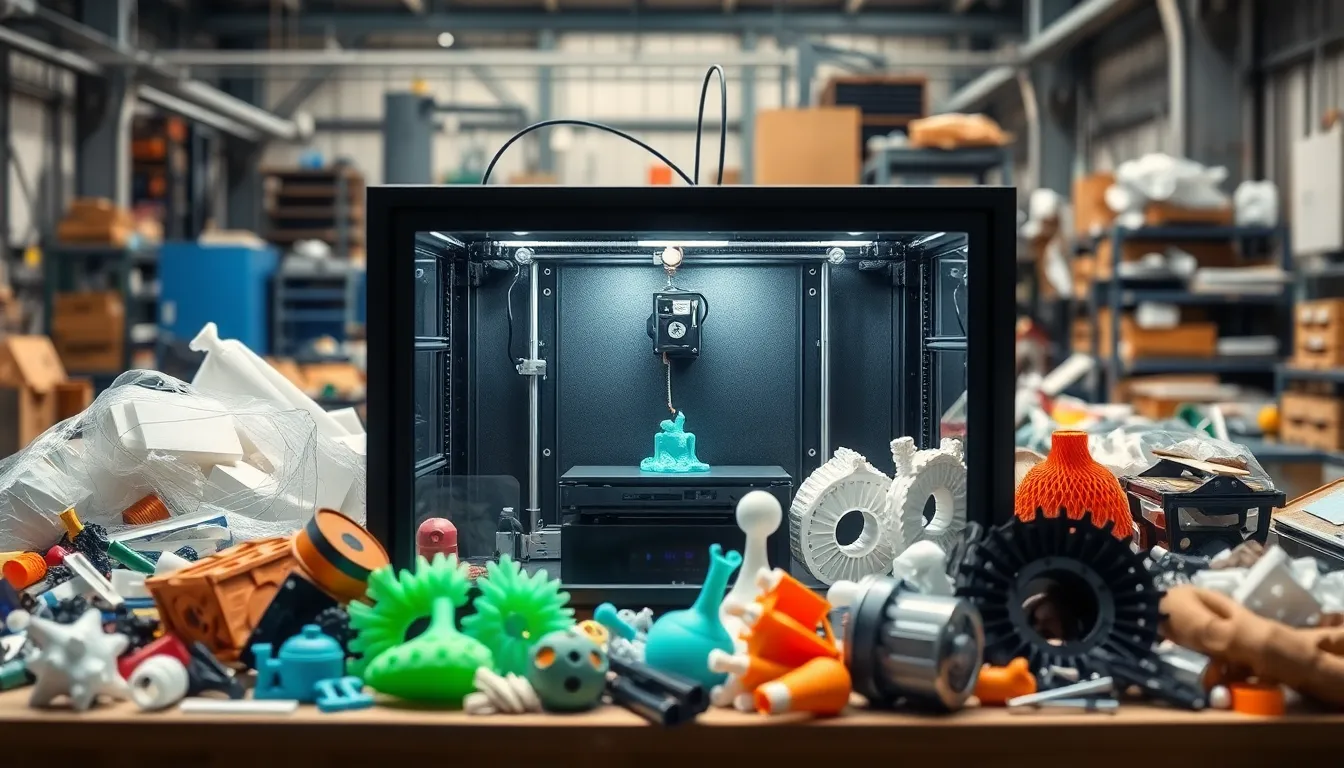In a world where convenience often trumps sustainability, 3D printing has burst onto the scene like a kid in a candy store. It promises to revolutionize manufacturing, reduce waste, and create custom items with just a click. But before anyone starts printing their dream gadgets, it’s crucial to unpack the environmental impacts lurking beneath the surface.
While it might seem like a futuristic miracle, 3D printing isn’t without its quirks. From energy consumption to material sourcing, the process has its own set of eco-concerns that could make Mother Nature raise an eyebrow. So, grab your biodegradable popcorn and let’s dive into the fascinating—and sometimes hilarious—world of 3D printing’s environmental footprint.
Table of Contents
ToggleOverview of 3D Printing Technology
3D printing refers to additive manufacturing processes that create objects layer by layer using digital models. This method relies on materials like plastics, metals, and ceramics, allowing for a diverse range of applications. Industries utilize 3D printing for prototyping, manufacturing, and even construction.
Technology varies among different types of 3D printers, including Fused Deposition Modeling (FDM), Stereolithography (SLA), and Selective Laser Sintering (SLS). FDM printers extrude molten material through a nozzle, building objects from the bottom up. SLA uses a laser to cure liquid resin into solid layers, producing highly detailed parts. SLS employs lasers to fuse powder materials, making complex geometries possible.
Applications of 3D printing span multiple sectors, including healthcare, automotive, and aerospace. In healthcare, customized implants and prosthetics demonstrate significant advancements. The automotive industry benefits from lightweight components and faster prototyping. Aerospace companies utilize 3D printing to reduce weight while enhancing performance and design flexibility.
Environmental considerations arise from both the materials used and the energy consumed during the printing process. Plastic waste issues stem from the extensive use of thermoplastics like ABS and PLA, while energy requirements vary based on printer types and designs. Renewable energy sources can offset some environmental impacts by powering 3D printing facilities.
Government regulations and industry standards keep evolving to address sustainability in 3D printing. Organizations are developing practices that minimize material waste and energy use. As the technology progresses, its environmental footprint may change, necessitating ongoing evaluations to find eco-friendly solutions.
Environmental Impacts of 3D Printing

3D printing significantly affects the environment through resource consumption and waste generation. Understanding these aspects provides insights into the sustainability of this technology.
Resource Consumption
3D printing relies heavily on various materials, including plastics and metals. Fused Deposition Modeling (FDM) primarily uses thermoplastics, which often derive from fossil fuels. Energy usage also varies by printer type; Stereolithography (SLA) and Selective Laser Sintering (SLS) typically consume more electricity due to their operational processes. Studies indicate that additive manufacturing processes can enhance material efficiency, using only the necessary amounts for creation. Different materials, including bioplastics, now offer more sustainable alternatives. Researchers and manufacturers continually explore innovations aimed at reducing resource intake, ensuring that the technology moves toward a more sustainable future.
Waste Generation
Waste generation poses significant concerns for 3D printing technologies. Excess material often results from failed prints or design alterations, contributing to plastic waste. Furthermore, the recycling of failed prints remains challenging due to the complexity of materials. A report indicated that the lifespan of 3D printed items impacts waste levels; longer-lasting objects reduce overall waste output. The introduction of biodegradable materials has emerged as a potential solution to mitigate plastic pollution. Companies are developing closed-loop systems to recycle 3D printed waste into new products. Innovations in design and material technology continue to shape waste reduction efforts, contributing to a greener manufacturing process.
Comparison With Traditional Manufacturing
3D printing demonstrates significant differences from traditional manufacturing methods, particularly in energy efficiency and material utilization. Understanding these differences highlights the environmental impacts of both processes.
Energy Efficiency
Energy consumption varies significantly between 3D printing and traditional methods. Conventional manufacturing often requires extensive machinery and long production runs, leading to higher overall energy use. In contrast, 3D printing can reduce energy demands by producing parts layer by layer. Some estimates suggest that additive manufacturing can consume up to 50% less energy than subtractive processes. Furthermore, using renewable energy sources in 3D printing facilities increases the potential for lowering carbon footprints. While energy usage may differ by printer type, the capacity for localized manufacturing often results in reduced transportation emissions.
Material Utilization
Material waste plays a crucial role in evaluating environmental impacts. Traditional manufacturing often generates substantial waste, especially in subtractive processes that cut away material. Comparatively, 3D printing offers enhanced material efficiency by using only the necessary amount of material needed for production. Some reports indicate that additive manufacturing can minimize waste more effectively than traditional methods, achieving material savings of approximately 90%. Innovations in bioplastics and recycled materials further enhance sustainability. As designers incorporate closed-loop systems, recycling opportunities for 3D printed products increase, contributing to a reduction in overall environmental impact.
Potential Solutions and Innovations
Innovations in 3D printing technology focus on sustainable practices that mitigate environmental impacts. Exploring sustainable materials and efficient energy use significantly enhances the ecological footprint of this manufacturing method.
Sustainable Materials
Sustainable materials play a critical role in reducing the carbon footprint of 3D printing. Bioplastics, derived from renewable resources, offer viable alternatives to traditional thermoplastics. They often feature biodegradability, enabling easier disposal and less impact on landfills. Recycling initiatives for 3D printing materials are gaining traction as well, with some companies developing closed-loop systems to repurpose waste. These practices not only minimize raw resource extraction but also support circular economy principles. Additionally, research is ongoing into composite materials that blend traditional plastics with bio-based elements, improving overall sustainability.
Efficient Energy Use
Efficient energy use significantly improves the environmental benefits of 3D printing. Many advanced printers are designed to consume less energy than conventional manufacturing methods. For instance, producing components layer by layer often requires up to 50% less energy compared to traditional processes. Incorporating renewable energy sources, such as solar or wind, can further reduce the carbon emissions associated with manufacturing. Innovations in printer technology also strive to optimize power consumption during operation. Additionally, energy-efficient designs can minimize heat waste and improve overall resource utilization, making 3D printing a more sustainable manufacturing option.
The environmental impacts of 3D printing present both challenges and opportunities. As this technology evolves it’s crucial to prioritize sustainable practices and materials. Innovations in bioplastics and recycling methods can significantly reduce waste and energy consumption.
By embracing renewable energy sources and optimizing production processes 3D printing has the potential to become a cornerstone of eco-friendly manufacturing. Ongoing research and development will play a vital role in addressing the ecological concerns associated with this transformative technology.
As industries continue to adopt 3D printing it’s essential to remain vigilant about its environmental footprint while striving for a greener future.



